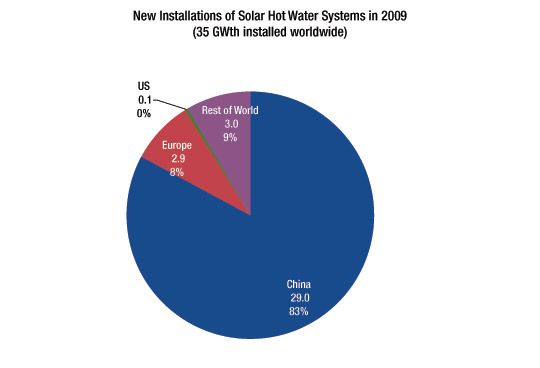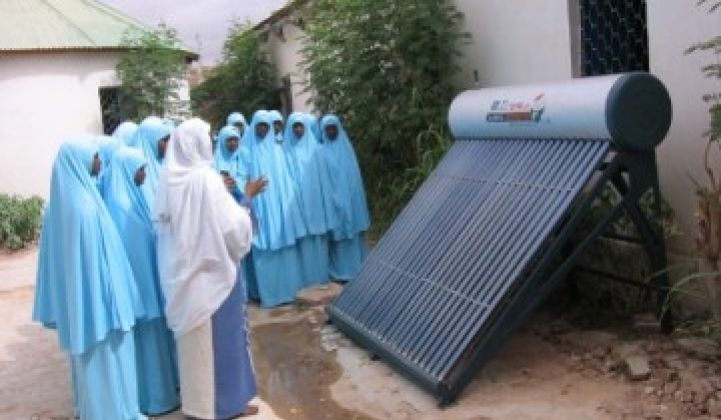At least that was the distinct impression one would get from attending Intersolar in San Francisco last week.
Slower-growing, smaller market, less innovation. Basically, solar thermal isn't sexy -- PV is.
Venture capital firms invest in PV because it has the potential to reinvent how electricity is generated.
Solar thermal heats up water for your morning shower. Not exactly a "game-changer."
But sometimes appearances can be deceiving. Solar thermal IS growing -- in fact, global volume growth in 2009 was higher for solar thermal than for PV. According to the recently published Global Demand report by GTM Research analyst Shayle Kann, worldwide PV modules installed grew 24% to 7,118 MW in 2009, whereas new capacity additions for solar thermal grew from 28 GM-thermal in 2008 to 35 GW-thermal in 2009, for a growth rate of 25%. And revenue growth was likely much stronger for solar water heating, as pricing for PV modules collapsed in 2009 (pricing was down 28%, resulting in an 11% drop in module revenues).
So while solar thermal is growing, the vast majority of that growth isn't happening here in the U.S. China dominates the market, both in terms of manufacturing (similar to PV), and in terms of installations (unlike PV, as discussed in our recent article on exports of China's modules).

Source: REN21, CREIA, ESTIF, SEIA, GTM Research
A recent report by REN21 (Renewable Energy Policy Network for the 21st Century) entitled "RENEWABLES 2010: GLOBAL STATUS REPORT" shows strong growth for solar thermal. According to the report, worldwide solar hot water and space heating capacity grew 21% from 149 GW-thermal in 2008 to 180 GW-thermal in 2009 (excluding unglazed swimming pool heating). China continues to dominate this market, both in terms of manufacturing and installations. China added about 29 GWth of solar hot water (SHW), which represents 83% of total worldwide new installations. Of the 180 GWth of global installed SHW capacity, China now has over 131 GWth (~73%).
Worldwide Solar Hot Water Capacity (Cumulative in GW-thermal)

Source: REN21, CREIA, ESTIF, SEIA, GTM Research
Solar water heating shipments in 2009 in the U.S. grew about 10% to 147 MWth according to estimates by SEIA, resulting in a cumulative installed capacity of 2.15 GWth (up from 2.0 GWth in 2008). This still represents less than 2% of worldwide installed capacity, and less than 1% of new installations. Hawaii remains the largest market, with 37% of all U.S. solar hot water (SHW) systems installed. Because of generous state rebates, a typical homeowner in Hawaii ends up paying for only 30% of the cost of a system, resulting in a payback period of less than 3 years. Solar hot water is much less successful in the rest of the U.S., where payback periods are generally more than 10 years (depending on state rebates, sunshine, and natural gas rates). According to Burkhard von Sprekelsen with Valliant Solar Systems, the typical payback period for a residential system is 16 years in California and 12 years in New York.
Here is how the math works in California:
A 2-panel solar hot water system costs around $7,900; after federal and state rebates, the cost works out to about $4,200. With natural gas prices at their current low levels, savings are only ~$260/year, so the payback period works out to 16 years. Not a very compelling investment opportunity. It should be noted that the math is better for larger commercial systems where the payback period is closer to five to eight years.
What will it take to make solar thermal take off in the U.S.? There are two possibilities:
1) Laws requiring that all new homes have solar hot water systems installed
2) More generous government incentives to get the payback periods closer to two to three years
Hawaii has demonstrated that it can be done. New York and other states have plans to follow in Hawaii's footsteps. Will they succeed? Let's hope so.



